Systematic Review of Sexual Health Promotion in England
VerifiedAdded on 2020/01/15
|8
|2254
|186
Report
AI Summary
This report presents a systematic review of the theoretical framework for analyzing and promoting sexual and reproductive health behaviors in England, UK. The review employs a comprehensive methodology, including article identification through databases like PubMed and Medline, eligibility assessments, and the application of inclusion and exclusion criteria. The study focuses on various aspects of sexual health, such as teenage pregnancies, HIV/AIDS, and sexually transmitted diseases. It outlines the methods used for abstract and full-text screening, quality analysis, and data extraction to ensure the validity and reliability of the findings. The report aims to provide evidence-based information to support collaborative efforts in improving sexual and reproductive health outcomes in England. The report also includes a detailed methodology and the inclusion and exclusion criteria for the articles reviewed.

Promoting Sexual Health
1
1
Paraphrase This Document
Need a fresh take? Get an instant paraphrase of this document with our AI Paraphraser
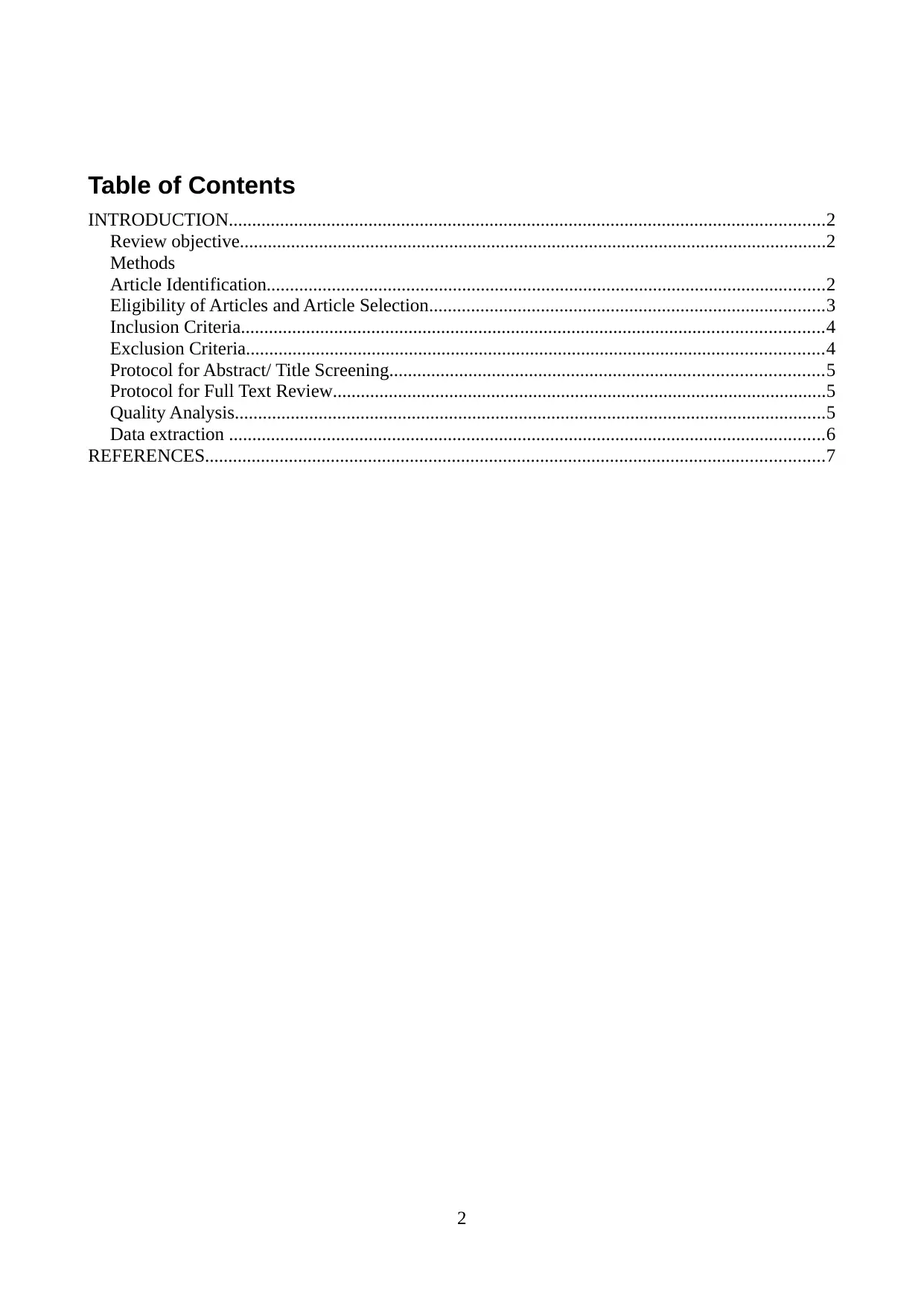
Table of Contents
INTRODUCTION................................................................................................................................2
Review objective..............................................................................................................................2
Methods
Article Identification........................................................................................................................2
Eligibility of Articles and Article Selection.....................................................................................3
Inclusion Criteria.............................................................................................................................4
Exclusion Criteria............................................................................................................................4
Protocol for Abstract/ Title Screening.............................................................................................5
Protocol for Full Text Review..........................................................................................................5
Quality Analysis...............................................................................................................................5
Data extraction ................................................................................................................................6
REFERENCES.....................................................................................................................................7
2
INTRODUCTION................................................................................................................................2
Review objective..............................................................................................................................2
Methods
Article Identification........................................................................................................................2
Eligibility of Articles and Article Selection.....................................................................................3
Inclusion Criteria.............................................................................................................................4
Exclusion Criteria............................................................................................................................4
Protocol for Abstract/ Title Screening.............................................................................................5
Protocol for Full Text Review..........................................................................................................5
Quality Analysis...............................................................................................................................5
Data extraction ................................................................................................................................6
REFERENCES.....................................................................................................................................7
2
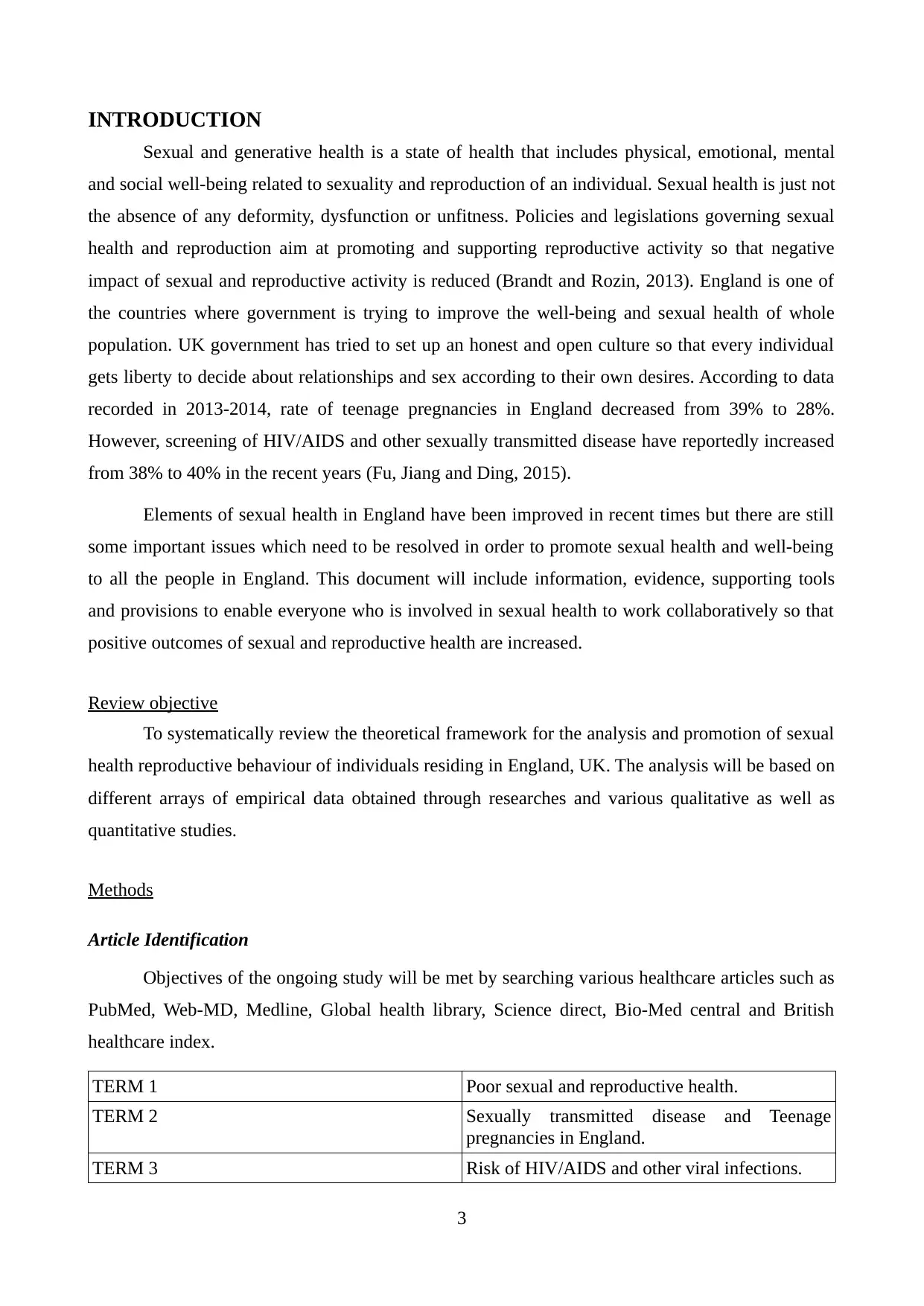
INTRODUCTION
Sexual and generative health is a state of health that includes physical, emotional, mental
and social well-being related to sexuality and reproduction of an individual. Sexual health is just not
the absence of any deformity, dysfunction or unfitness. Policies and legislations governing sexual
health and reproduction aim at promoting and supporting reproductive activity so that negative
impact of sexual and reproductive activity is reduced (Brandt and Rozin, 2013). England is one of
the countries where government is trying to improve the well-being and sexual health of whole
population. UK government has tried to set up an honest and open culture so that every individual
gets liberty to decide about relationships and sex according to their own desires. According to data
recorded in 2013-2014, rate of teenage pregnancies in England decreased from 39% to 28%.
However, screening of HIV/AIDS and other sexually transmitted disease have reportedly increased
from 38% to 40% in the recent years (Fu, Jiang and Ding, 2015).
Elements of sexual health in England have been improved in recent times but there are still
some important issues which need to be resolved in order to promote sexual health and well-being
to all the people in England. This document will include information, evidence, supporting tools
and provisions to enable everyone who is involved in sexual health to work collaboratively so that
positive outcomes of sexual and reproductive health are increased.
Review objective
To systematically review the theoretical framework for the analysis and promotion of sexual
health reproductive behaviour of individuals residing in England, UK. The analysis will be based on
different arrays of empirical data obtained through researches and various qualitative as well as
quantitative studies.
Methods
Article Identification
Objectives of the ongoing study will be met by searching various healthcare articles such as
PubMed, Web-MD, Medline, Global health library, Science direct, Bio-Med central and British
healthcare index.
TERM 1 Poor sexual and reproductive health.
TERM 2 Sexually transmitted disease and Teenage
pregnancies in England.
TERM 3 Risk of HIV/AIDS and other viral infections.
3
Sexual and generative health is a state of health that includes physical, emotional, mental
and social well-being related to sexuality and reproduction of an individual. Sexual health is just not
the absence of any deformity, dysfunction or unfitness. Policies and legislations governing sexual
health and reproduction aim at promoting and supporting reproductive activity so that negative
impact of sexual and reproductive activity is reduced (Brandt and Rozin, 2013). England is one of
the countries where government is trying to improve the well-being and sexual health of whole
population. UK government has tried to set up an honest and open culture so that every individual
gets liberty to decide about relationships and sex according to their own desires. According to data
recorded in 2013-2014, rate of teenage pregnancies in England decreased from 39% to 28%.
However, screening of HIV/AIDS and other sexually transmitted disease have reportedly increased
from 38% to 40% in the recent years (Fu, Jiang and Ding, 2015).
Elements of sexual health in England have been improved in recent times but there are still
some important issues which need to be resolved in order to promote sexual health and well-being
to all the people in England. This document will include information, evidence, supporting tools
and provisions to enable everyone who is involved in sexual health to work collaboratively so that
positive outcomes of sexual and reproductive health are increased.
Review objective
To systematically review the theoretical framework for the analysis and promotion of sexual
health reproductive behaviour of individuals residing in England, UK. The analysis will be based on
different arrays of empirical data obtained through researches and various qualitative as well as
quantitative studies.
Methods
Article Identification
Objectives of the ongoing study will be met by searching various healthcare articles such as
PubMed, Web-MD, Medline, Global health library, Science direct, Bio-Med central and British
healthcare index.
TERM 1 Poor sexual and reproductive health.
TERM 2 Sexually transmitted disease and Teenage
pregnancies in England.
TERM 3 Risk of HIV/AIDS and other viral infections.
3
⊘ This is a preview!⊘
Do you want full access?
Subscribe today to unlock all pages.

Trusted by 1+ million students worldwide
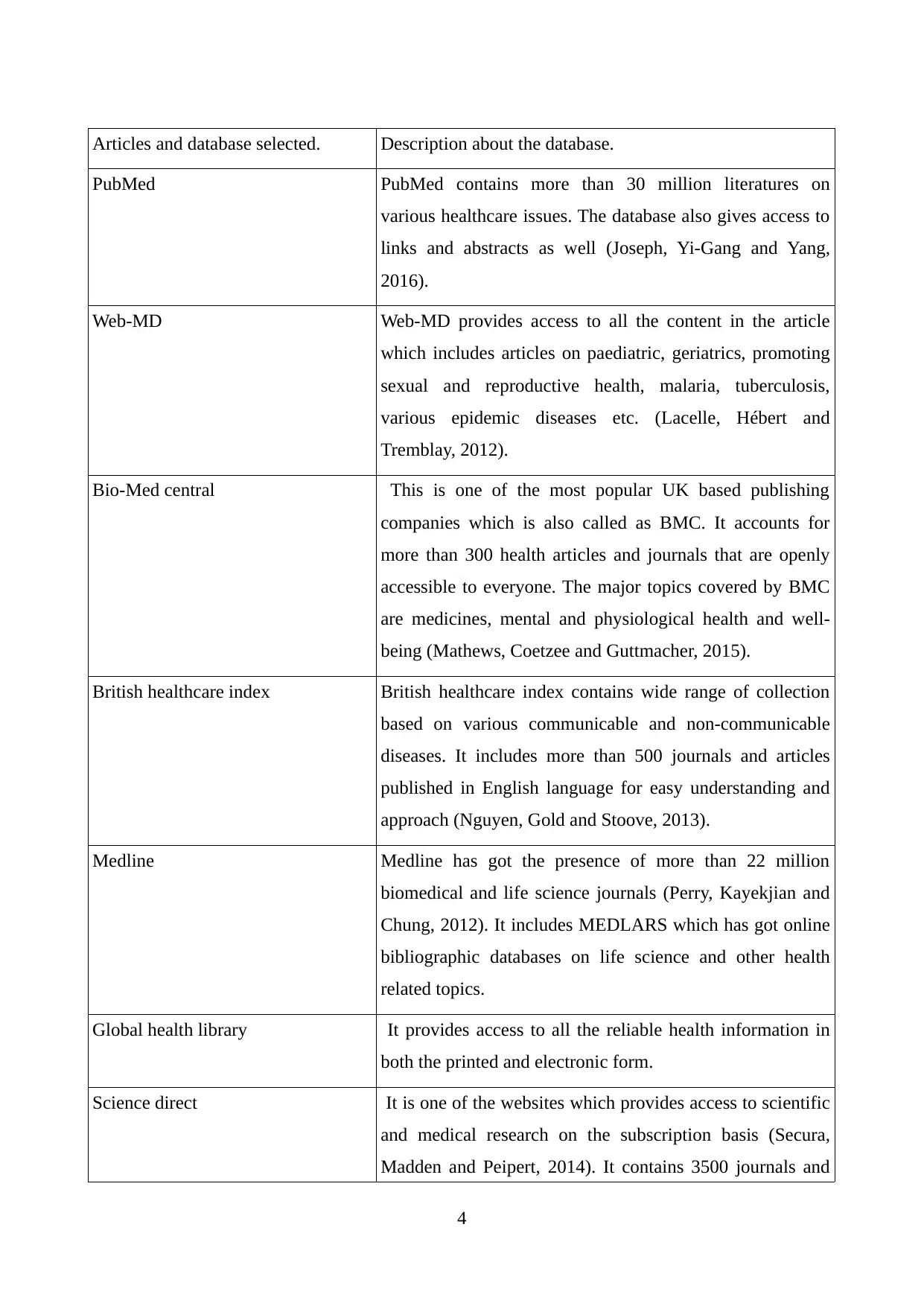
Articles and database selected. Description about the database.
PubMed PubMed contains more than 30 million literatures on
various healthcare issues. The database also gives access to
links and abstracts as well (Joseph, Yi-Gang and Yang,
2016).
Web-MD Web-MD provides access to all the content in the article
which includes articles on paediatric, geriatrics, promoting
sexual and reproductive health, malaria, tuberculosis,
various epidemic diseases etc. (Lacelle, Hébert and
Tremblay, 2012).
Bio-Med central This is one of the most popular UK based publishing
companies which is also called as BMC. It accounts for
more than 300 health articles and journals that are openly
accessible to everyone. The major topics covered by BMC
are medicines, mental and physiological health and well-
being (Mathews, Coetzee and Guttmacher, 2015).
British healthcare index British healthcare index contains wide range of collection
based on various communicable and non-communicable
diseases. It includes more than 500 journals and articles
published in English language for easy understanding and
approach (Nguyen, Gold and Stoove, 2013).
Medline Medline has got the presence of more than 22 million
biomedical and life science journals (Perry, Kayekjian and
Chung, 2012). It includes MEDLARS which has got online
bibliographic databases on life science and other health
related topics.
Global health library It provides access to all the reliable health information in
both the printed and electronic form.
Science direct It is one of the websites which provides access to scientific
and medical research on the subscription basis (Secura,
Madden and Peipert, 2014). It contains 3500 journals and
4
PubMed PubMed contains more than 30 million literatures on
various healthcare issues. The database also gives access to
links and abstracts as well (Joseph, Yi-Gang and Yang,
2016).
Web-MD Web-MD provides access to all the content in the article
which includes articles on paediatric, geriatrics, promoting
sexual and reproductive health, malaria, tuberculosis,
various epidemic diseases etc. (Lacelle, Hébert and
Tremblay, 2012).
Bio-Med central This is one of the most popular UK based publishing
companies which is also called as BMC. It accounts for
more than 300 health articles and journals that are openly
accessible to everyone. The major topics covered by BMC
are medicines, mental and physiological health and well-
being (Mathews, Coetzee and Guttmacher, 2015).
British healthcare index British healthcare index contains wide range of collection
based on various communicable and non-communicable
diseases. It includes more than 500 journals and articles
published in English language for easy understanding and
approach (Nguyen, Gold and Stoove, 2013).
Medline Medline has got the presence of more than 22 million
biomedical and life science journals (Perry, Kayekjian and
Chung, 2012). It includes MEDLARS which has got online
bibliographic databases on life science and other health
related topics.
Global health library It provides access to all the reliable health information in
both the printed and electronic form.
Science direct It is one of the websites which provides access to scientific
and medical research on the subscription basis (Secura,
Madden and Peipert, 2014). It contains 3500 journals and
4
Paraphrase This Document
Need a fresh take? Get an instant paraphrase of this document with our AI Paraphraser
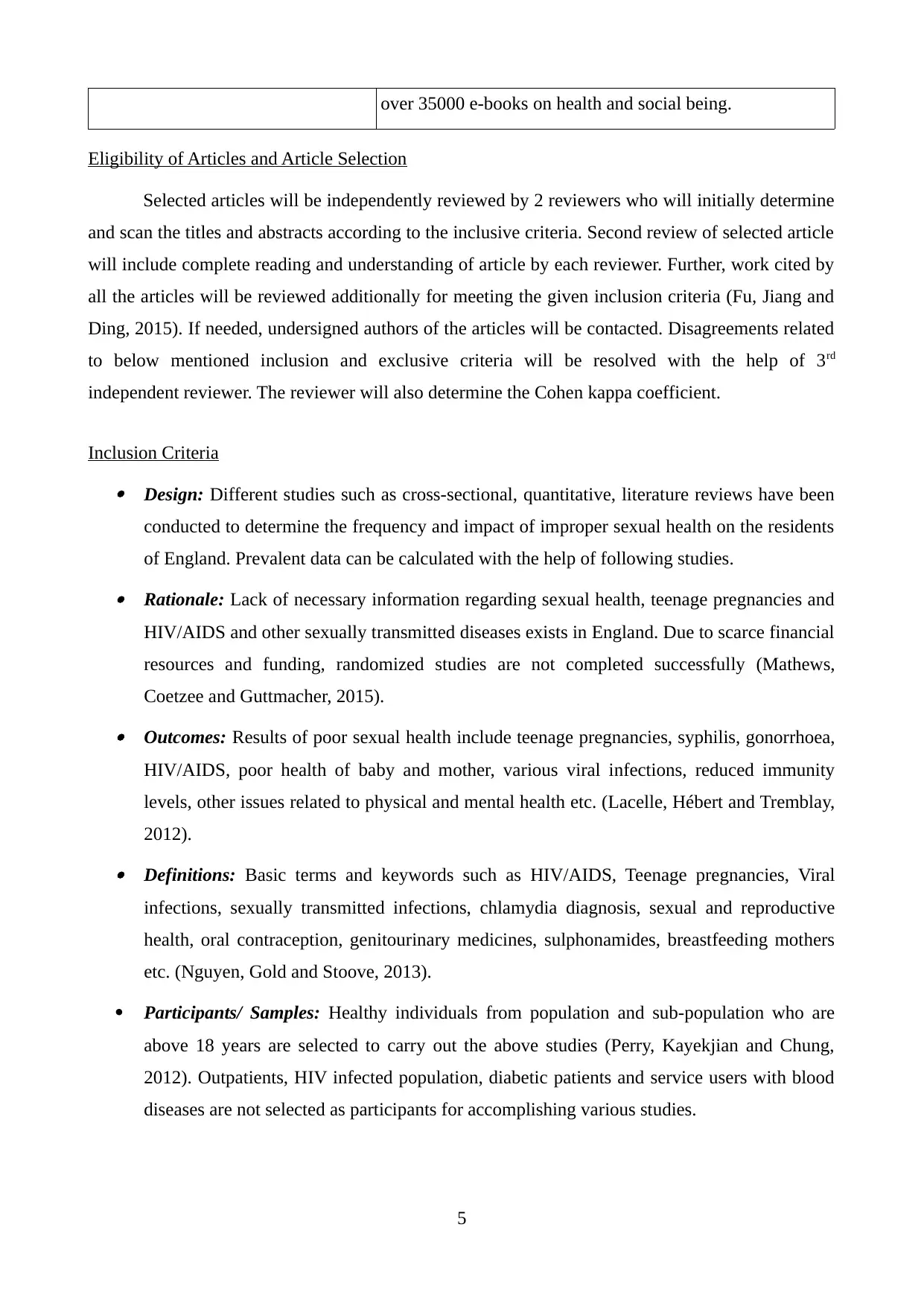
over 35000 e-books on health and social being.
Eligibility of Articles and Article Selection
Selected articles will be independently reviewed by 2 reviewers who will initially determine
and scan the titles and abstracts according to the inclusive criteria. Second review of selected article
will include complete reading and understanding of article by each reviewer. Further, work cited by
all the articles will be reviewed additionally for meeting the given inclusion criteria (Fu, Jiang and
Ding, 2015). If needed, undersigned authors of the articles will be contacted. Disagreements related
to below mentioned inclusion and exclusive criteria will be resolved with the help of 3rd
independent reviewer. The reviewer will also determine the Cohen kappa coefficient.
Inclusion Criteria
Design: Different studies such as cross-sectional, quantitative, literature reviews have been
conducted to determine the frequency and impact of improper sexual health on the residents
of England. Prevalent data can be calculated with the help of following studies.
Rationale: Lack of necessary information regarding sexual health, teenage pregnancies and
HIV/AIDS and other sexually transmitted diseases exists in England. Due to scarce financial
resources and funding, randomized studies are not completed successfully (Mathews,
Coetzee and Guttmacher, 2015).
Outcomes: Results of poor sexual health include teenage pregnancies, syphilis, gonorrhoea,
HIV/AIDS, poor health of baby and mother, various viral infections, reduced immunity
levels, other issues related to physical and mental health etc. (Lacelle, Hébert and Tremblay,
2012).
Definitions: Basic terms and keywords such as HIV/AIDS, Teenage pregnancies, Viral
infections, sexually transmitted infections, chlamydia diagnosis, sexual and reproductive
health, oral contraception, genitourinary medicines, sulphonamides, breastfeeding mothers
etc. (Nguyen, Gold and Stoove, 2013).
Participants/ Samples: Healthy individuals from population and sub-population who are
above 18 years are selected to carry out the above studies (Perry, Kayekjian and Chung,
2012). Outpatients, HIV infected population, diabetic patients and service users with blood
diseases are not selected as participants for accomplishing various studies.
5
Eligibility of Articles and Article Selection
Selected articles will be independently reviewed by 2 reviewers who will initially determine
and scan the titles and abstracts according to the inclusive criteria. Second review of selected article
will include complete reading and understanding of article by each reviewer. Further, work cited by
all the articles will be reviewed additionally for meeting the given inclusion criteria (Fu, Jiang and
Ding, 2015). If needed, undersigned authors of the articles will be contacted. Disagreements related
to below mentioned inclusion and exclusive criteria will be resolved with the help of 3rd
independent reviewer. The reviewer will also determine the Cohen kappa coefficient.
Inclusion Criteria
Design: Different studies such as cross-sectional, quantitative, literature reviews have been
conducted to determine the frequency and impact of improper sexual health on the residents
of England. Prevalent data can be calculated with the help of following studies.
Rationale: Lack of necessary information regarding sexual health, teenage pregnancies and
HIV/AIDS and other sexually transmitted diseases exists in England. Due to scarce financial
resources and funding, randomized studies are not completed successfully (Mathews,
Coetzee and Guttmacher, 2015).
Outcomes: Results of poor sexual health include teenage pregnancies, syphilis, gonorrhoea,
HIV/AIDS, poor health of baby and mother, various viral infections, reduced immunity
levels, other issues related to physical and mental health etc. (Lacelle, Hébert and Tremblay,
2012).
Definitions: Basic terms and keywords such as HIV/AIDS, Teenage pregnancies, Viral
infections, sexually transmitted infections, chlamydia diagnosis, sexual and reproductive
health, oral contraception, genitourinary medicines, sulphonamides, breastfeeding mothers
etc. (Nguyen, Gold and Stoove, 2013).
Participants/ Samples: Healthy individuals from population and sub-population who are
above 18 years are selected to carry out the above studies (Perry, Kayekjian and Chung,
2012). Outpatients, HIV infected population, diabetic patients and service users with blood
diseases are not selected as participants for accomplishing various studies.
5
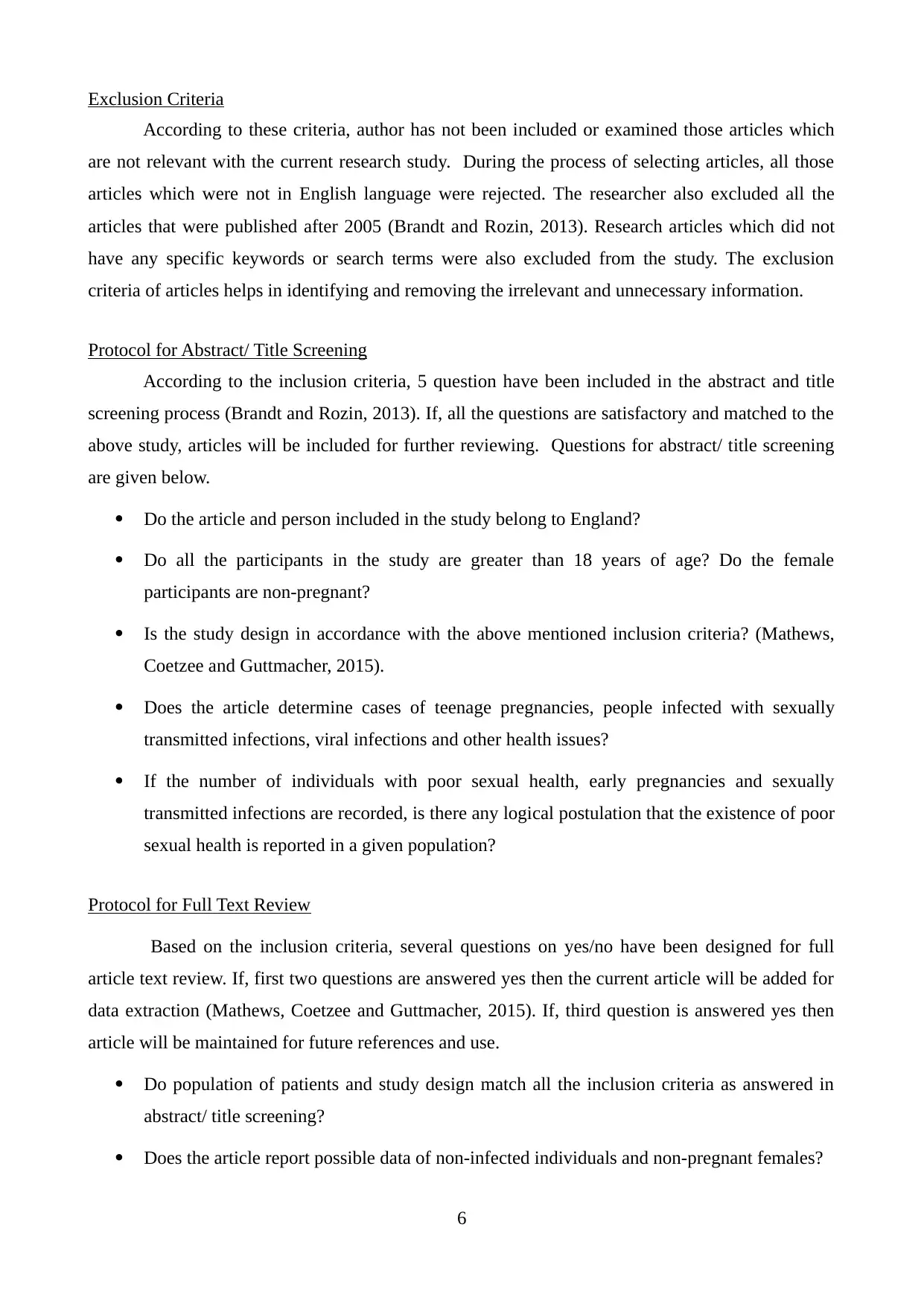
Exclusion Criteria
According to these criteria, author has not been included or examined those articles which
are not relevant with the current research study. During the process of selecting articles, all those
articles which were not in English language were rejected. The researcher also excluded all the
articles that were published after 2005 (Brandt and Rozin, 2013). Research articles which did not
have any specific keywords or search terms were also excluded from the study. The exclusion
criteria of articles helps in identifying and removing the irrelevant and unnecessary information.
Protocol for Abstract/ Title Screening
According to the inclusion criteria, 5 question have been included in the abstract and title
screening process (Brandt and Rozin, 2013). If, all the questions are satisfactory and matched to the
above study, articles will be included for further reviewing. Questions for abstract/ title screening
are given below.
Do the article and person included in the study belong to England?
Do all the participants in the study are greater than 18 years of age? Do the female
participants are non-pregnant?
Is the study design in accordance with the above mentioned inclusion criteria? (Mathews,
Coetzee and Guttmacher, 2015).
Does the article determine cases of teenage pregnancies, people infected with sexually
transmitted infections, viral infections and other health issues?
If the number of individuals with poor sexual health, early pregnancies and sexually
transmitted infections are recorded, is there any logical postulation that the existence of poor
sexual health is reported in a given population?
Protocol for Full Text Review
Based on the inclusion criteria, several questions on yes/no have been designed for full
article text review. If, first two questions are answered yes then the current article will be added for
data extraction (Mathews, Coetzee and Guttmacher, 2015). If, third question is answered yes then
article will be maintained for future references and use.
Do population of patients and study design match all the inclusion criteria as answered in
abstract/ title screening?
Does the article report possible data of non-infected individuals and non-pregnant females?
6
According to these criteria, author has not been included or examined those articles which
are not relevant with the current research study. During the process of selecting articles, all those
articles which were not in English language were rejected. The researcher also excluded all the
articles that were published after 2005 (Brandt and Rozin, 2013). Research articles which did not
have any specific keywords or search terms were also excluded from the study. The exclusion
criteria of articles helps in identifying and removing the irrelevant and unnecessary information.
Protocol for Abstract/ Title Screening
According to the inclusion criteria, 5 question have been included in the abstract and title
screening process (Brandt and Rozin, 2013). If, all the questions are satisfactory and matched to the
above study, articles will be included for further reviewing. Questions for abstract/ title screening
are given below.
Do the article and person included in the study belong to England?
Do all the participants in the study are greater than 18 years of age? Do the female
participants are non-pregnant?
Is the study design in accordance with the above mentioned inclusion criteria? (Mathews,
Coetzee and Guttmacher, 2015).
Does the article determine cases of teenage pregnancies, people infected with sexually
transmitted infections, viral infections and other health issues?
If the number of individuals with poor sexual health, early pregnancies and sexually
transmitted infections are recorded, is there any logical postulation that the existence of poor
sexual health is reported in a given population?
Protocol for Full Text Review
Based on the inclusion criteria, several questions on yes/no have been designed for full
article text review. If, first two questions are answered yes then the current article will be added for
data extraction (Mathews, Coetzee and Guttmacher, 2015). If, third question is answered yes then
article will be maintained for future references and use.
Do population of patients and study design match all the inclusion criteria as answered in
abstract/ title screening?
Does the article report possible data of non-infected individuals and non-pregnant females?
6
⊘ This is a preview!⊘
Do you want full access?
Subscribe today to unlock all pages.

Trusted by 1+ million students worldwide

Is the study based on case control criteria in which people infected with AIDS and other
sexually transmitted diseases are selected? If yes, then the following article needs to be
eliminated from the study (Fu, Jiang and Ding, 2015).
Quality Analysis
Each selected article will be individually examined for quality purpose with the help of
objective methodological ways and different criteria for prevalence studies. Questions based on
internal and external validity, sampling methods, members of selected population, accurate and
precise source of determining the disease and adequate ability etc. should be included in quality
analysis of prevalence studies (Perry, Kayekjian and Chung, 2012). According to literature and
different methodological standards, several series of questions will be modified so that issue of
quality can be addressed effectively.
Data extraction
After selecting and characterizing different articles for inclusion criteria, two authors will
independently monitor all the articles which are used for data extraction. Articles will include
standard and pre-formulated forms (Health statistics and Data Sources, 2016). The standard form
will comprise study design, population included in the study, size of the study, statistical data of
patients, study dates, terminology related to sexual health and diseases etc. It will also include
morbidity rate due to sexually transmitted disease in a particular area, relative frequency of
individuals infected with HIV/AIDS, adolescent pregnancies and other transmitted infections.
Errors during the process of data extraction will be resolved by the collective review of all the
articles. If necessary, authors of all the articles will be contacted.
7
sexually transmitted diseases are selected? If yes, then the following article needs to be
eliminated from the study (Fu, Jiang and Ding, 2015).
Quality Analysis
Each selected article will be individually examined for quality purpose with the help of
objective methodological ways and different criteria for prevalence studies. Questions based on
internal and external validity, sampling methods, members of selected population, accurate and
precise source of determining the disease and adequate ability etc. should be included in quality
analysis of prevalence studies (Perry, Kayekjian and Chung, 2012). According to literature and
different methodological standards, several series of questions will be modified so that issue of
quality can be addressed effectively.
Data extraction
After selecting and characterizing different articles for inclusion criteria, two authors will
independently monitor all the articles which are used for data extraction. Articles will include
standard and pre-formulated forms (Health statistics and Data Sources, 2016). The standard form
will comprise study design, population included in the study, size of the study, statistical data of
patients, study dates, terminology related to sexual health and diseases etc. It will also include
morbidity rate due to sexually transmitted disease in a particular area, relative frequency of
individuals infected with HIV/AIDS, adolescent pregnancies and other transmitted infections.
Errors during the process of data extraction will be resolved by the collective review of all the
articles. If necessary, authors of all the articles will be contacted.
7
Paraphrase This Document
Need a fresh take? Get an instant paraphrase of this document with our AI Paraphraser
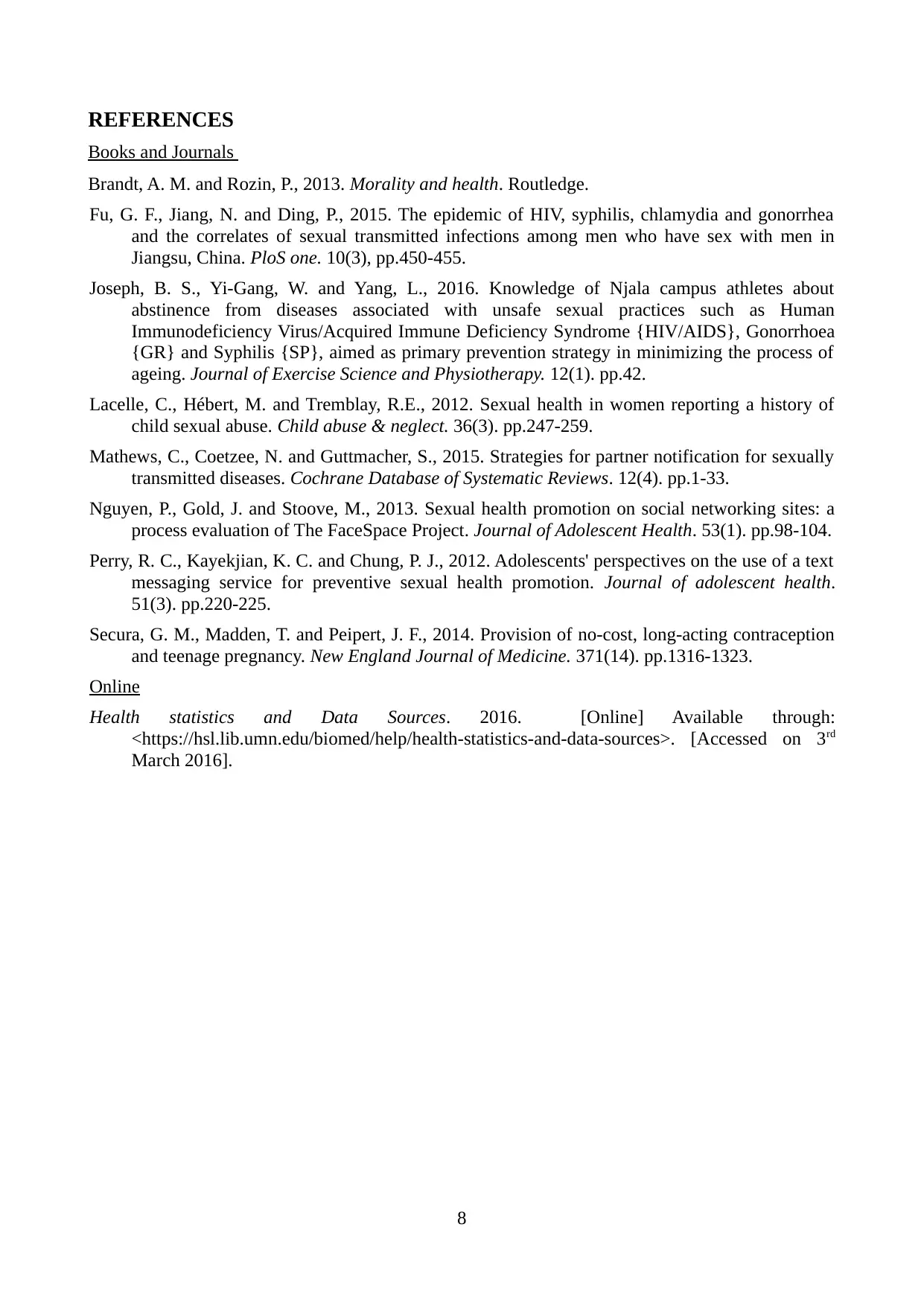
REFERENCES
Books and Journals
Brandt, A. M. and Rozin, P., 2013. Morality and health. Routledge.
Fu, G. F., Jiang, N. and Ding, P., 2015. The epidemic of HIV, syphilis, chlamydia and gonorrhea
and the correlates of sexual transmitted infections among men who have sex with men in
Jiangsu, China. PloS one. 10(3), pp.450-455.
Joseph, B. S., Yi-Gang, W. and Yang, L., 2016. Knowledge of Njala campus athletes about
abstinence from diseases associated with unsafe sexual practices such as Human
Immunodeficiency Virus/Acquired Immune Deficiency Syndrome {HIV/AIDS}, Gonorrhoea
{GR} and Syphilis {SP}, aimed as primary prevention strategy in minimizing the process of
ageing. Journal of Exercise Science and Physiotherapy. 12(1). pp.42.
Lacelle, C., Hébert, M. and Tremblay, R.E., 2012. Sexual health in women reporting a history of
child sexual abuse. Child abuse & neglect. 36(3). pp.247-259.
Mathews, C., Coetzee, N. and Guttmacher, S., 2015. Strategies for partner notification for sexually
transmitted diseases. Cochrane Database of Systematic Reviews. 12(4). pp.1-33.
Nguyen, P., Gold, J. and Stoove, M., 2013. Sexual health promotion on social networking sites: a
process evaluation of The FaceSpace Project. Journal of Adolescent Health. 53(1). pp.98-104.
Perry, R. C., Kayekjian, K. C. and Chung, P. J., 2012. Adolescents' perspectives on the use of a text
messaging service for preventive sexual health promotion. Journal of adolescent health.
51(3). pp.220-225.
Secura, G. M., Madden, T. and Peipert, J. F., 2014. Provision of no-cost, long-acting contraception
and teenage pregnancy. New England Journal of Medicine. 371(14). pp.1316-1323.
Online
Health statistics and Data Sources. 2016. [Online] Available through:
<https://hsl.lib.umn.edu/biomed/help/health-statistics-and-data-sources>. [Accessed on 3rd
March 2016].
8
Books and Journals
Brandt, A. M. and Rozin, P., 2013. Morality and health. Routledge.
Fu, G. F., Jiang, N. and Ding, P., 2015. The epidemic of HIV, syphilis, chlamydia and gonorrhea
and the correlates of sexual transmitted infections among men who have sex with men in
Jiangsu, China. PloS one. 10(3), pp.450-455.
Joseph, B. S., Yi-Gang, W. and Yang, L., 2016. Knowledge of Njala campus athletes about
abstinence from diseases associated with unsafe sexual practices such as Human
Immunodeficiency Virus/Acquired Immune Deficiency Syndrome {HIV/AIDS}, Gonorrhoea
{GR} and Syphilis {SP}, aimed as primary prevention strategy in minimizing the process of
ageing. Journal of Exercise Science and Physiotherapy. 12(1). pp.42.
Lacelle, C., Hébert, M. and Tremblay, R.E., 2012. Sexual health in women reporting a history of
child sexual abuse. Child abuse & neglect. 36(3). pp.247-259.
Mathews, C., Coetzee, N. and Guttmacher, S., 2015. Strategies for partner notification for sexually
transmitted diseases. Cochrane Database of Systematic Reviews. 12(4). pp.1-33.
Nguyen, P., Gold, J. and Stoove, M., 2013. Sexual health promotion on social networking sites: a
process evaluation of The FaceSpace Project. Journal of Adolescent Health. 53(1). pp.98-104.
Perry, R. C., Kayekjian, K. C. and Chung, P. J., 2012. Adolescents' perspectives on the use of a text
messaging service for preventive sexual health promotion. Journal of adolescent health.
51(3). pp.220-225.
Secura, G. M., Madden, T. and Peipert, J. F., 2014. Provision of no-cost, long-acting contraception
and teenage pregnancy. New England Journal of Medicine. 371(14). pp.1316-1323.
Online
Health statistics and Data Sources. 2016. [Online] Available through:
<https://hsl.lib.umn.edu/biomed/help/health-statistics-and-data-sources>. [Accessed on 3rd
March 2016].
8
1 out of 8
Related Documents
Your All-in-One AI-Powered Toolkit for Academic Success.
+13062052269
info@desklib.com
Available 24*7 on WhatsApp / Email
![[object Object]](/_next/static/media/star-bottom.7253800d.svg)
Unlock your academic potential
Copyright © 2020–2025 A2Z Services. All Rights Reserved. Developed and managed by ZUCOL.





